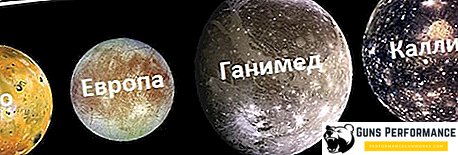August 12, 2000 This date will forever enter the modern history of Russia. It was on this day in the Barents Sea that one of the most advanced ships of the Russian Navy, the nuclear submarine Kursk, was crashed. This catastrophe led to the death of the entire crew of the boat, in the mournful list of the dead 118 people. To this day, many questions connected with this tragedy have not been disclosed. The truth is hidden from Russian society, and no one knows whether we will ever know the true causes of the K-141’s death.

Submarine K-141 "Kursk"
The nuclear-powered Kursk belonged to the Antey-Project 949A ships. The history of the submarines of this project dates back to the late 60s of the last century. The submarines of the project "Antey" are considered experts of one of the most advanced multi-purpose boats to date. The boat "Kursk" was laid in Severodvinsk in 1992, in 1994 it was launched, and in the same year she was accepted into the Northern Fleet of the Russian Navy. The first commander of the "Kursk" was the captain of the 2nd rank Rozhkov. At the time of his death, this ship was one of the most advanced in the Russian fleet.
The Antey-class boats (Oscar-II, according to the NATO classification) were designed in the USSR to counter enemy aircraft carriers and its nuclear submarines. Submarines of this class are armed with Granit rockets and torpedoes. They have a very low noise and unobtrusive. These are real "aircraft carrier killers", imperceptible and deadly.

Here are the main characteristics of the Kursk K-141.
Displacement, t | |
| Underwater | 14700 |
| Surfaced | 23860 |
Sizes, m | |
| Length | 154 |
| Width | 18,2 |
| Draft | 9 |
Speed | |
| Surface water | 15 knots |
| Underwater | 33 knots |
| Immersion depth, m | 600 |
| Power point | 2 nuclear reactors OK 650-B |
| Armament | 24 cruise missiles P-700 (Granit) 4 torpedo tubes |
| Autonomy | 120 days |
| Crew | 130 people |
The submarine "Kursk" was considered one of the best ships of the Northern Fleet. In 1999, the boat made an autonomous voyage to the Mediterranean Sea, successfully completing all the tasks of command. The last commander of the Kursk was the captain of the 1st rank Lyachin.

Accident - in detail about the death of submarine K-141 "Kursk"
On August 10, 2000, K-141 took part in exercises in the Barents Sea. The submarine was supposed to conduct rocket and torpedo firing.
On August 12, at 11.28, the acoustics of the nuclear-powered cruiser Peter the Great recorded a strong bang, after which the Kursk did not make a planned torpedo attack, and then did not come out at a fixed time for a communication session. August 13, an atomic submarine cruiser was found lying at the bottom.
From this point on, rescue work begins, which, however, were not crowned with success. The military reported that they had established contact with the submarine. Russian and Norwegian divers descended to the wreck, and deep-water descent vehicles worked. All Russia watched for rescue work with bated breath.

On August 21, Norwegian divers managed to open the hatch and get inside the ship. The boat was filled with water. On the same day, the leadership of the Northern Fleet officially announced the death of the entire crew.
The following year, the dead submarine was towed to the shipyard. The investigation began. According to the official version, the nuclear submarine cruiser Kursk sank because of the explosion of a training torpedo, followed by the explosion of the entire ammunition. The blast completely destroyed the first few compartments of the boat, and it was filled with water within six to eight hours. Representatives of the prosecutor's office said that the fire was raging along the entire length of the boat.

During the investigation several ship logbooks were examined. Records of any emergency situations are missing.
Alternative versions of the death of the submarine K-141
From the moment of the announcement of the official version by the authorities to the present day, disputes over the causes of the death of one of the best ships of the Russian fleet have not abated. Too many people believe that the authorities are not telling the whole truth. Among the doubters are many professional sailors and specialists associated with the navy. Now there are several different versions explaining what exactly happened on that ill-fated day and why Captain Lyachin could not bring his ship back to his native harbor.
There is a version of Vice-Admiral Ryazantsev. He believes that the initial cause of the disaster was a torpedo explosion, which led to the flooding of the first compartment and the collision of the submarine with the ground. The impact on the bottom led to the detonation of the remaining torpedoes, which led to such terrible consequences.

One of the popular versions of the cause of death "Kursk" is a torpedo attack of an American submarine. French director Jean-Michel Carré even shot a documentary confirming this hypothesis. According to her supporters, two American submarines "Toledo" and "Memphis" watched the exercises of the Northern Fleet (this is a common practice). Russian and American submarines collided, and the second American submarine struck a torpedo attack on the Kursk after the commander of the K-141 ordered to attack the enemy.
Supporters of this version claim that the Russian authorities deliberately concealed the truth about the torpedo attack in order to prevent a conflict (perhaps even a military one) with the United States.
As a variant of this version, there is a hypothesis about the collision of the "Kursk" with a submarine of one of the NATO countries, which led to an explosion of torpedoes on the Russian nuclear-powered icebreaker. Moreover, after the disaster, information appeared in the media about the detection of a rescue buoy in the disaster area. Perhaps it was released by a “alien” submarine also injured in the collision.

The history of the underwater confrontation between the two superpowers during the Cold War confirms this version.
This version has been studied in detail by the Russian media and has its followers among the sailors. In their opinion, the pattern of events was as follows: a strike by a foreign boat on a torpedo tube, then an explosion of a single torpedo, a strike on the ground, and a detonation of the entire ammunition.
There is also a version about a mine from the time of the Second World War, but few believe in this version.
There is also a version that the Kursk was accidentally sunk by the newest missile fired from the nuclear-powered cruiser Peter the Great.
Representatives of the relatives of crew members do not believe in the official version and believe that the authorities do not speak the truth. They believe that in the ninth compartment after the disaster, the sailors were still alive for more than two days. According to them, if the leadership of the Navy immediately turned to foreigners for help, then perhaps the list of the dead would be less. A lot of investigation materials have not been made public.
It's hard to believe that we will get all the answers in this tragic story.












